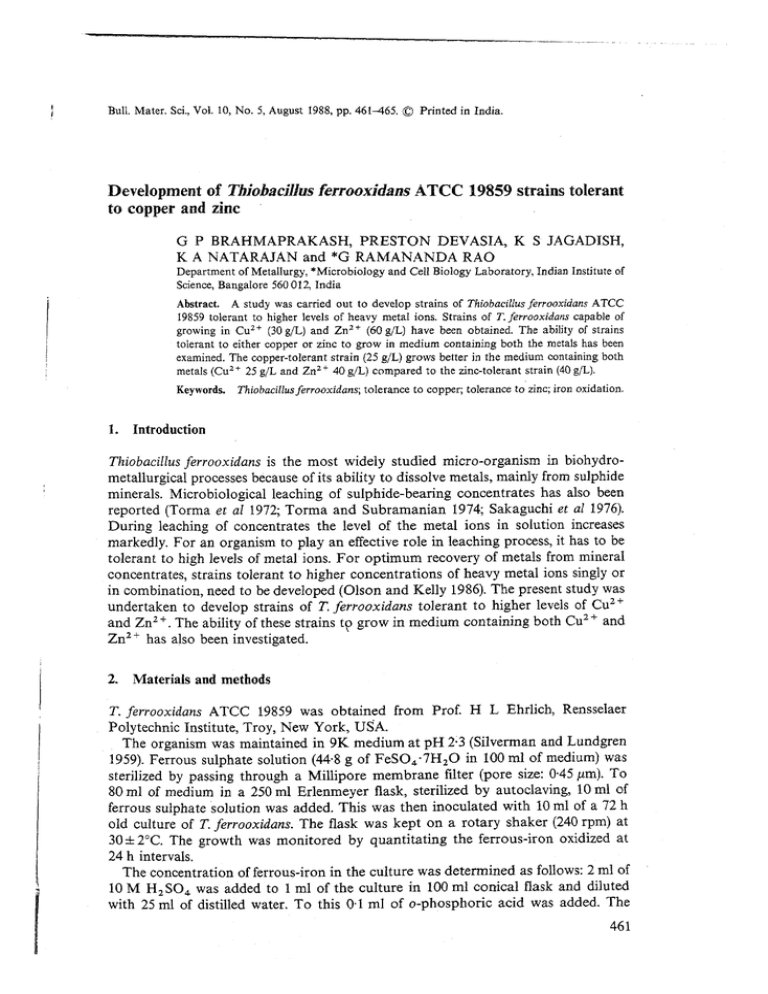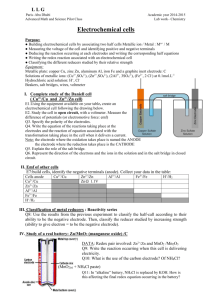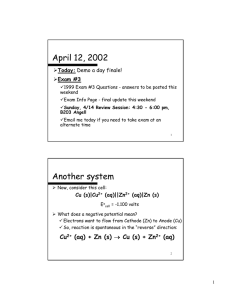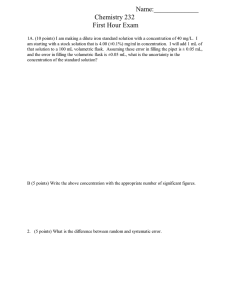-
advertisement

- --..- I Bull. Mater. Sci., Vol. 10, No. 5, August 1988, pp. 461-465. 0 Printed in India. Development of Thiobaci14us ferromidans ATCC 69859 strains tolerant to copper and zinc G P BRAHMAPRAKASH, PRESTON DEVASIA, K S JAGADISH, K A NATARAJAN and *G RAMANANDA RAO Department of Metallurgy, *Microbiology and Cell Biology Laboratory, Indian Institute of Science, Bangalore 560 012, India Abstract. A study was carried out to develop strains of Thiobacillus fe~rooxidans ATCC 19859 tolerant to higher levels of heavy metal ions. Strains of T. ferrooxidans capable of growing in Cu2+ (30 g/L) and Z n Z + (60 g/L) have been obtained. The ability of strains tolerant to either copper or zinc to grow in medium containing both the metals has been examined. The copper-tolerant strain (25 g/L) grows better in the medium containing both metals (Cup 25 g/L and Zn2+ 40 g/L) compared to the zinc-tolerant strain (40 g/L). Keywords. Thiobacillusferrooxidans; tolerance to copper; tolerance to zinc; iron oxidation. 1. Introduction Thiobacillus ferrooxidans is the most widely studied micro-organism in biohydrometallurgical processes because of its ability to dissolve metals, mainly from sulphide minerals. Microbiological leaching of sulphide-bearing concentrates has also been reported (Torma et a1 1972; Torma and Subramanian 1974; Sakaguchi et a1 1976). During leaching of concentrates the level of the metal ions in solution increases markedly. For an organism to play an effective role in leaching process, it has to be tolerant to high levels of metal ions. For optimum recovery of metals from mineral concentrates, strains tolerant to higher concentrations of heavy metal ions singly or in combination, need to be developed (Olson and Kelly 1986). The present study was undertaken to develop strains of T.ferrooxidans tolerant to higher levels of Cu2+ and Zn2'. The ability of these strains tp grow in medium containing both Cu2+ and Zn2+ has also been investigated. 1 I ! I I 2. Materials and methods T. ferrooxidans ATCC 19859 was obtained from Prof. H L Ehrlich, Rensselaer Polytechnic Institute, Troy, New York, USA. The organism was maintained in 9K medium at pH 2.3 (Silverman and Lundgren 1959). Ferrous sulphate solution (44.8 g of FeS0,-7H,O in 100 ml of medium) was sterilized by passing through a Millipore membrane filter (pore size: 0.45 pm). To 80 ml of medium in a 250 ml Erlenmeyer flask, sterilized by autoclaving, 10 ml of ferrous sulphate solution was added. This was then inoculated with 10 ml of a 72 h old culture of T. ferrooxidans. The flask was kept on a rotary shaker (240 rpm) at 30f 2°C. The growth was monitored by quantitating the ferrous-iron oxidized at 24 h intervals. The concentration of ferrous-iron in the culture was determined as follows: 2 ml of 10 M H2S0, was added to 1 ml of the culture in 100 ml conical flask and diluted with 25 ml of distilled water. To this 0.1 ml of o-phosphoric acid was added. The 462 G P Brahmaprakash et a1 solution was titrated with 0-025 N potassium dichromate using 0.2 ml of barium diphenyl amine sulphonate as the indicator. Under the conditions of assay 1 ml of potassium dichromate solution used corresponds to 1.4 mg of ferrous-iron. Strains of T. ferrooxidans tolerant to high levels of metals were obtained by repeated culturing of the organism in 9K medium supplemented with indicated levels of Cu2+ and Zn2+.The sulpkate salts of the metals were used in the study and were of analar grade quality. Rsdox potential and pH were monitored with a platinum-saturated calomel electrode couple and combined electrode respectively. Strains of T. ferrooxidans made tolerant to either Cu2+ (25 g/L) or Zn2+ (40 g/L) were used to examine their ability to grow in media containing both the metals at the levels indicated. For this 9K medium supplemented with Cu2+ (25 g/L) and Zn2+ (40 g/L) was inoculated with the culture (10% v/v) of the tolerant strains. The growth was monitored by following the extent of ferrous iron oxidized by the method described above. 3. Results and discussion The growth pattern of T. ferrooxidans ATCC 19859 in 9 K medium containing different levels of Cu2+ is shown in figure 1A. The growth of the organism was slightly inhibited upto 48 h at 5 g/L of Cu2+. However, this inhibition was not evident at later stages of growth (96 h). A marked inhibition was observed at 10 g/L or more of Cu2+. However, on prolonged incubation (192 En) the organism showed recovery in growth at 10 g/L of Cu2+ but not at 20 g/L of Cu2+ (figure 1A). The growth profile of T. ferrooxidans tolerant to 10 g/E of Cu2+ when subcultured into medium containing higher levels of Cu2+ is presented in figure 1B. It is evident that Time (h) Time (h) Figure 1. Development of tolerance of T. Jerrooxidans to increasing levels of CuZf. Tolerance of (A) unadapted and (B) adapted (10 g/L) strains to different concentrations of cu2+. T.ferrooxidans strains tolerant to copper and zinc 463 the strain tolerant to 10 g/L of Cu2+ was able to grow at higher concentrations of Cu2' (20 g/L and above) while an unadapted culture was totally inhibited. The redox potential values were found to increase rapidly when a tolerant strain was cultured in a medium containing metal ions. At the same time there was no significant changes in pH values during growth. Earlier reports have shown inhibitory concentrations of Cu2' to be more than 1 g/L (Tuovinen et a1 1971) whereas T.ferrooxidans ATCC 19859 is inhibited only at 5 g/L and above. Figure 2A represents the growth of T.ferrooxidans in medium containing different levels of Zn2'. The growth of the organism was inhibited by Zn2+ (20 g/L) only during initial stages (48 h). After 48 h the growth in the presence of Zn2' was comparable with the control. The extent of inhibition observed during the initial 48 h was proportional to the concentration of Zn2+ in the medium. The ability of the strain made tolerant to Zn2+ (20 g/L) to grow at higher levels of Zn2' is presented in figure 2B. The adaptedJtolerant strain shows a better growth rate than the unadapted strain. However, at high concentrations of Zn2+ an inhibition was observed. The tolerance to Zn2+ could however be developed by repeated subculturing in the presence of the metal ion. Other reports have shown that T. ferrooxidans was inhibited by Zn2+ at more than 10 g/L (Tuovinen et a1 1971j. In this study we have developed T. ferrooxidans ATCC 19859 strains tolerant to Cu2+ (25-30 g/L) and Zn2' (60 g/L). The strain tolerant to Zn2+ (40 g/L) when cultured in medium containing Cu2+ (row 1) shows poor growth upto 12 days (table 1). Under similar conditions Cu2+tolerant strain (row 2) grows very well in the presence of z n 2 + (40 g/L) and reaches the maximal growth much earlier (12 days). It showed a consistently higher rate of growth compared to the Zn2+-tolerant one. Time ( h ) ' Figure 2. Development of tolerance of T. ferrooxidans to increasing levels of Zn2+. Tolerance of (A) unadapted and (B) adapted (20 g/L) strains to different concentrations of ZnZ+. Table 1. Growth of T.ferrooxidans tolerant to Cu2' and Zn", both metals. Cultured in 9K medium containing Culture Zinc tolerant strain? Copper tolerant strain* Copper tolerant strain Zinc tolerant strain Copper tolerant strain +zinc tolerant strain@ Unadapted strain in 9K medium containing Incubation in days 2 6 9 12 25 Cu2 25 g/L Zn2+40 g/L Cu2+25 g/L -kZn2+40 g/L Cu2' 25 giL + Zn2 40 g/L Cu2+25 g/L 4- Zn2 '40 g/L 1.6# 1.8 2.5 21 1.9 3.3 2.6 2.5 2.8 2.5 8.4 3.2 2.8 3.3 6.1 25 2-2 6-5 2.8 2.6 2-8 Cu2+25 g/L+Zn2+ 40 g/L 0.1 2.1 2.3 2.6 3.6 + ' - 6.8 3.5 6.8 # ~ i ~ u r are e s (mg/ml) Fe2' oxidized; t40 g/L of Zn2+, full growth occurs in 96 h; *25 g/L of Cu2+,full growth occurs in 96 h; @Inoculum consisted of 5 ml Cu2+and Zn2+ tolerant cultures each. The @u3+-tolerantstrain (row 3) can well tolerate the presence of both metals and reaches maximal growth by 25 days. In contrast !he Zn2+-tolerant strain (row 4) grew only 50% as efficient and is comparable with the growth shown by the unadapted strain. The 9 K medium containing both the metals was inoculated with equal volumes of cultures tolerant to Cu2+ and Zn2+. The growth pattern was similar to the one shown by Cu2+-tolerant strain. The results from the present study reveal that a Cu2 -tolerant strain is better equipped to overcome the inhibition caused by Zn2+.Tuovinen et al(l971) have shown that T. ferrooxidans adapted to ainc or nickel are more tolerant to copper compared to unadapted cultures. The mechanism of metal tolerance is supposed to be due to the ability of the cells to exclude netal ions from their internal structures (Kuznetsov et al 1963). Ingledew and Cobley (1980) and Mjoli and Kulpa (personal communication) have shown that Fez+ oxidation enzymes are membrane bound in T.ferrooxidans. The lag phase that was observed on ixposure to metal ions indicates the possibility of an adaptation process taking place for the protection of membrane-bound Fez oxidation enzymes. Also the prolonged lag phase may represent the time when natural selection of metal-tolerant cells takes place (Groudeva et a1 1981) while the other susceptible cells in the population succumb to the toxicity of the heavy metals. Thus, development of strains tolerant to Cu2+ and Zn2' could be the result of adaptation and/or selection of tolerant strains. + + Acknowledgement The authors thank the DST for financial assistance for this research project through hdo-US-STI. References Groudeva V I, Groudev S N and Markov K 1 1981 Comptes rendus de PAcademie trulgare des Sciences 34 375 Ingledew J H and Cobley J G 1980 Biochim. Biophys. Acta 590 141 Kunznetsov S I, Ivanov M V and Lyalikova N N 1963 in Introduction to geological microbiology (New York: McGraw Hill Book Co) i T.ferrooxidans strains tolerant to copper and zinc Olson G J and Kelly D P 1986 Biotechnol. Prog. 2 1 Sakaguchi M, Silver M and Tonna A E 1976 Biotechnol. Bioeng. 18 1091 Silverman M P and Lundgren D G 1959 J. Bacteriol. 77 642 Torma A E and Subramanian K N 1974 Int. J. Miner. Process. 1 15 Torma A E, Walden C C, Duncan D W and Branion R M R 1972 Biotechnol. Bioeng. 14 777 Tuovinen 0 H, Niemela S I and Gyllenberg H G 1971 Antonie van Leeuwenhoek 37 489








